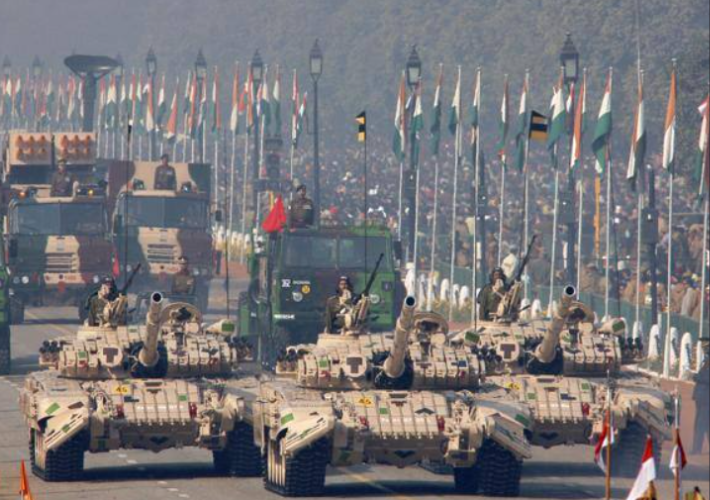Editor’s Note
What should the Indian Defence budget be? Should it be a defined percentage of the GDP, as is often the expectation, or, are there other yardsticks that could be used to resolve the issue. Notwithstanding the methodology adopted, a more realistic estimate of budgetary requirements is called for, especially when the adequacy of our defence preparedness status needs to be resilient enough to face enhanced threat levels, both along our land and sea borders.
…………………………………………………..
It comes as no surprise that India’s military expenditure was adjudged by the Stockholm International Peace Research Institute (SIPRI) to be the fourth largest in the world in 2023. India has been among the top four spenders since 2018, climbing up rapidly since 2013 when it was ranked ninth.
The SIPRI report on the trends in world military expenditure in 2023, released last April, ranks India behind the United States of America (USA), China and Russia. In 2019, India had overtaken Russia to become the third largest spender, but the war with Ukraine pushed Russia back to the third slot in 2022. Meanwhile, Saudi Arabia retained its position as the fifth largest spender in 2023.
This ranking dissembles the vast gap in what each of these countries spent in absolute terms in 2023. At US $ 916 bn, USA’s military expenditure was more than the combined expenditure of the next four: China (US $ 296 bn), Russia (US $ 109 bn), India (US $ 83.6 bn), and Saudi Arabia (US $ 75.8 bn).
China’s military expenditure -more than thrice that of India’s- is viewed with concern in India, and often quoted to bolster the case for a substantially higher defence budget. The concern is genuine. An irredentist Beijing is in no mood to undo more than half a century of territorial transgressions. The ongoing virtual standoff in the Galwan Valley in Eastern Ladakh since 15 June, 2020 is the latest in a series of such transgressions.
It is remarkable that New Delhi has so far managed the situation without any abnormal increase in the defence budget, but it is undeniable that higher sums of money are required to acquire and sustain military capabilities needed for safeguarding India’s territorial integrity and interests in the Indian Ocean, power projection, anti-piracy operations, humanitarian assistance and disaster relief, et al.
Three different approaches have been tried out to deal with this problem. The most popular approach that held sway for a long time was to somehow ensure that the defence budget is pegged at 3% of the gross domestic product (GDP), though its rationale was never explained by the proponents of the idea.
This approach was vigorously supported by the Standing Committee on Defence (SCoD) even in the face of its apparent financial unviability. The debate that ensued ignored the fact that GDP is only the cumulative value of final goods and services produced in a country and bought by the consumers in a given period of time, and not the allocatable income of the government.
The second approach was to secure a high percentage of annual growth in the defence budget, but it too did not yield the desired outcome. The Compound Annual Growth Rate (CAGR) of revenue and capital budget between FYs 2019-20 and 2024-25 was a little less than 7% and 11% respectively. This was in keeping with the trend of budget allocation in the preceding years.
The third approach was to assess the annual requirement, irrespective of its ratio to the GDP or what it amounted to in terms of year-on-year increase. The requirement so assessed was projected to the Ministry of Finance (MoF) without much, if any, scrutiny by the Ministry of Defence (MoD). This too did not help as the allocation invariably fell short of the projection.
For the Financial Year (FY) 2000-01, the budget allocated for the revenue and capital expenditure of the three services, was about 80% of the initial requirement projected by them to the MoD; by FY 2004-05 it dropped to 74%. The situation has improved of late. In the FY 2023-24, armed forces’ allocation was 92.64% of what they had demanded. In fact, the allocation under the capital segment was almost 100% of the projected requirement, the shortfall being a mere ₹ 540 crore. Under the revenue segment also, the armed forces were allocated more than 89% of the requirement projected by them.
Does it then mean that the budget allocated in the FY 2023-24 -as indeed in the FY 2000-01- was adequate, and the yawning gap between India’s and China’s military expenditure is of little consequence? The narrowing gap between projection and allocation would suggest that but to go by this factor alone would be misleading.
According to the Fifteenth Finance Commission, which submitted its report to the government in October 2020, the armed forces had projected a requirement of ₹3,46,130 crore and ₹3,87,919 crore for capital and revenue expenditure respectively for the FY 2023-24. However, what was projected by them at the time of formulation of the union budget for FY 2023-24 was ₹ 2,89,676 crore and ₹ 1,48,955 respectively.
The vast difference between the requirement projected to the Finance Commission and the MoF exposes the inadequacy of the budget outlay, even without drawing any comparison with China’s military expenditure. But, it also calls into question the method used for estimating the budgetary support required for modernisation and operational sustenance of the armed forces.
Instead of first focussing on defence planning and evolving a realistic methodology for estimating the budgetary requirements, the tendency has been to assume that India’s military capabilities are primarily proportional to the budget outlays and propagate debatable ideas to deal with the problem. One such idea was to create a non-lapsable modernisation fund for the armed forces.
The fifteenth Finance Commission, in fact, recommended constitution of such a fund with a corpus of ₹ 1,38,354 crore to meet the estimated shortfall of ₹ 8,45,136 crore under the capital segment of the defence budget between FYs 2021-22 and 2025-26. The fund is yet to be set up, almost four years after it was recommended by the Finance Commission, probably because of the belated realisation that it would be of limited use.
Resource allocation is a zero-sum game, influenced by the state of economy and a host of other factors, especially the country’s foreign policy objectives and the competing demands from other sectors like healthcare, education, infrastructure development, agriculture, environment, and so on. This is borne out by the comparative analysis of China’s and USA’s military expenditure.
China’s military expenditure rose consecutively for 29 years, which is the longest unbroken streak recorded by any country in the SIPRI Military Expenditure Database, recording a growth of 150% between 1994-2013, but it dropped to about 60% between 2013-23, resulting in an increase of US $ 108 bn in its defence budget during this period.
According to the SIPRI report, this trend reflects the slowing down of Chinese economic growth from double digit to about 6-7% during the past decade. It also reflects the way China is managing its military objectives by forging strategic relations across the world and refining its military doctrines, particularly with regard to rightsizing the Peoples’ Liberation Army. In contrast, while its economy grew by just about 2-3%, USA’s defence budget increased by US $ 276 bn during the same period because of its larger strategic interests.
India’s defence budget is unlikely to catch up with China’s, much less that of the USA’s, any time soon. Bemoaning isn’t going to help. The MoD will have to work around the financial limitations and imperatives of the Indian economy and polity, and formulate financially viable long- and short-term capability development plans. It’s an area crying out for immediate attention. To sum up in the words of Elizabeth Ann Warren, a former law professor and senior United States senator, “Budgeting your money is the key to having enough.”
Amit Cowsish






















